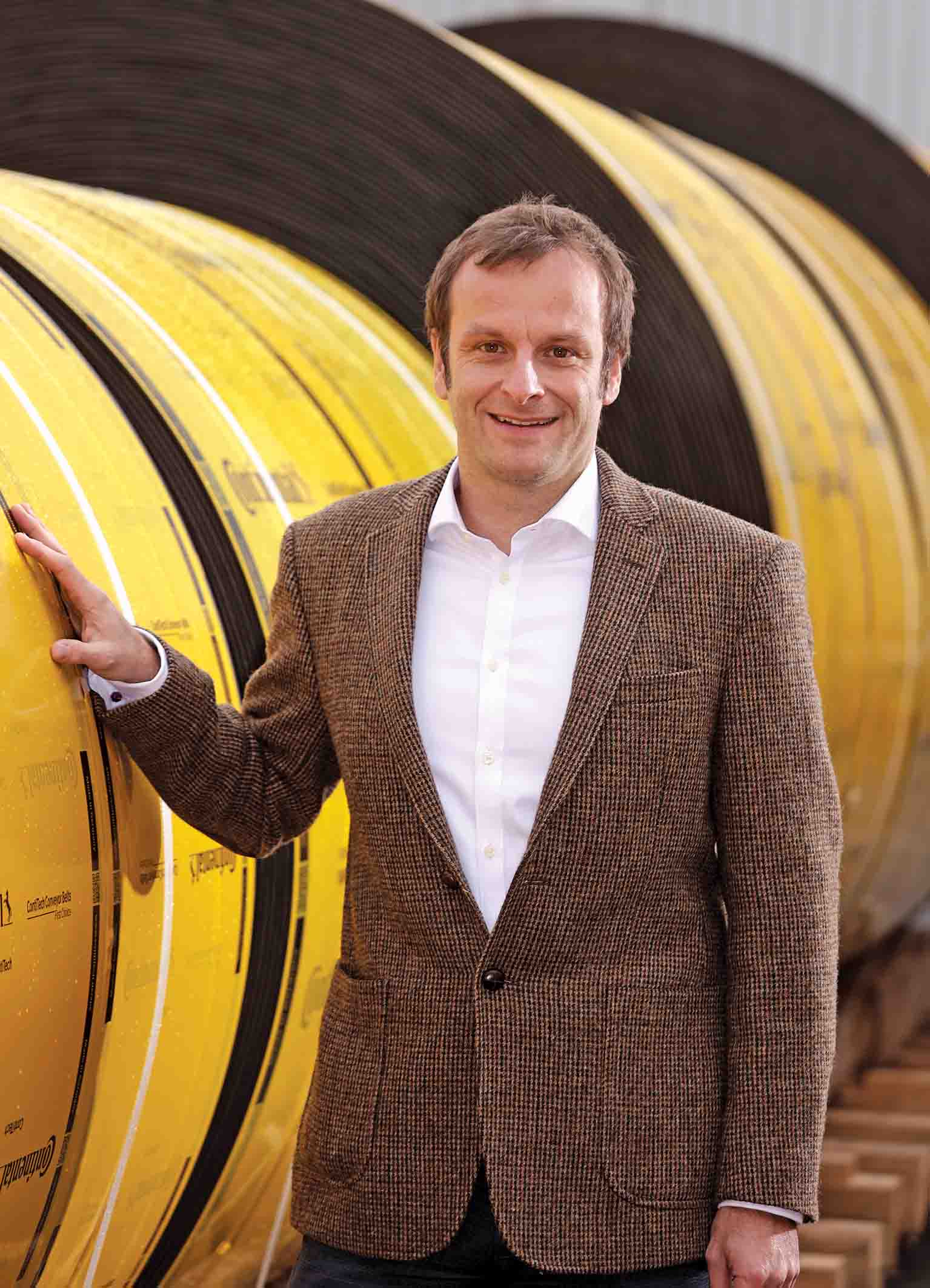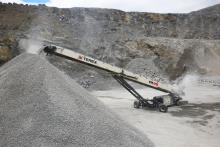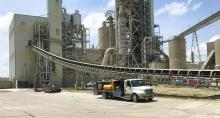
Conveyor belts are becoming increasingly sophisticated, as is the technology used to monitor their performance and maintenance needs. This creates huge potential efficiency savings for aggregate and cement product suppliers. Guy Woodford reports.
CBG says having a conveyor belt continually monitored by its X-ray technology-based CBGuard Life Extender X5 (CBGuard) system will supply quarry operators with detailed, digitised real-time information about its overall condition and the state of all of its components. This, CBG claims, will ensure a conveyor belt’s safe and efficient operation. Any critical damage to the belt automatically triggers a CBGuard alarm, allowing any damage to be immediately addressed, thus reducing costly downtime and further belt deterioration.
Best placed in the bottom run of the conveyor, the CBGuard, consisting of an X-ray generator with tube, a receiver and a control unit, allows the user to play a complete or clip-form video at any time and speed, reproducing the x-ray image of a belt. The location of every fault identified by the system within the belt is said to be clearly shown. As it can be accessed over the internet by authorised personnel, CBGuard allows users to check the health of their conveyor belt anytime, anywhere in the world.
The CBGuard’s X-ray generator produces artificial X-ray energy from electricity. The X-ray beam penetrates the conveyor belt and impinges on the detection board, which then, CBG explains, forms a grey-scale photograph based on different absorptions of the conveyor belt areas. This happens millions of times with a running belt. The radiation source is insulated, stresses CBG. However, a safety zone with a fence around two metres distance around the CBGuard system needs to be installed. There is an interlocking system on the doors of the fence and the X5 cabinet. Once doors are opened, the generator will be switched off. Equipped with a number of safety devices, CBG states that the system can only be started if a unique dongle and password are applied. Beyond the safety fence, CBG states that the radiation produced when using CBGuard is less than 1 µSv/h (microSievert/hour).
More than 300 CBGuard systems are said by the company to be successfully in operation, including in a number of quarry settings. Designed as a standalone system, it can, says CBG, be used as an integral part of the plant’s monitoring network (IIoT – Industrial Internet of Things) and communicate with other electronically controlled conveyor parts and logistical processes. The CBGuard is said to be suitable for conveyor belts with widths of up to 3,200mm, a maximum thickness of 60mm, and a maximum speed of 8m/s. Its standard image resolution is 1.6mm x 1.6mm, but 0.8mm x 0.8mm is also available.
CBG stresses that the lifetime of the CBGuard’s X-ray tube for continuous operation is limited, with the system’s software signalling in time when the tube is in need of replacement. A spare generator tube module can be shipped with each CBGuard.
Emphasising its flexible use, CBG says the CBGuard can be operated continuously, or for one belt revolution every day, week or month. The system automatically starts and finishes a complete cycle inspection and produces a report, listing the belt deficiencies.
As Beumer notes, a conveying system has to meet high requirements to ensure safe and economic clinker transport in cement plants. The cement clinker leaves the clinker cooler of the kiln line at temperatures of up to 200°C, or up to 600°C if the coating collapses, and is temporarily stored in the clinker silo. To ensure a trouble-free transport of the clinker, a conveying system must withstand these high temperatures. This is where Beumer says its apron conveyors can be used.
Continually optimised by the company’s engineers in Beckum, Germany, Beumer apron conveyors are said to be extremely robust and can navigate through complicated routings and considerable conveying heights. “We generally use the heavy-duty Beumer double sprocket chains as traction elements,” explains Michael Brachthäuser, director Business Unit Cement at Beumer. This, Beumer says, makes it possible to handle inclinations of up to 60° at a speed of 0.3 metres/second. “In order to increase performance we developed a version with the cells mounted to a belt instead of a chain,” adds Brachthäuser.
The basis for the above highlighted variant is said to be Beumer’s proven belt technology, which is also used in bucket elevators. The belt is reinforced with steel wires and can be designed in different widths. In the material feed area, special deflector plates protect the belt against hot coating that collapses when the kiln is not in continuous use. “With up to 1,300m³ of clinker/hour, belt apron conveyors achieve a higher conveying capacity than conventional apron conveyors,” claims Brachthäuser. This, Beumer says, can be attributed to a higher running speed of up to 0.6m/second. Angles of inclination of up to 60° are also said to be possible. Wear and tear that occurs frequently on a chain can be practically eliminated when using a belt and lubricating the system is not necessary.
According to Beumer, the lighter and more compact design of this solution reduces the costs for the steel structure and the entire project. The entire belt lies with its surface on the drive and return pulley, thus, Beumer states, the unwanted polygon effect caused by the central chain is said to be avoided. This is said by the German manufacturer to ensure quiet running and low noise emission, and prevents additional exposure of the plant and adjacent buildings to load vibrations and noise.
The Beumer belt apron conveyor is, the company says, an optimal choice for system modernisations. Thanks to faster conveying speeds, higher quantities of material can be transported while keeping the existing conveyor frames and steel bridges. “A concrete example: An apron conveyor with a chain of 1,600 millimetres width and 131m centre distance weighs 128 tonnes,” explains Brachthäuser. “The steel structure weighs about 80tonnes. An 800 x 131m belt apron conveyor capable of conveying the same capacity weighs only 90tonnes – that’s 38tonnes less than the chain version. For the belt version, the net costs for the equipment are 25% lower, as the steel structure is approximately 30tonnes lighter and weighs only 50tonnes. A smaller drive unit can be used due to the reduced size, which further lowers the operational costs compared to conventional apron conveyors.”
“Our conveyor belt portfolio for industrial applications is growing steadily. Service and digitalisation also offer the business further potential. Furthermore, many of our customers are merging into increasingly larger units, meaning that our way of thinking and working is taking on new dimensions to meet their changing needs and requirements,” says Dr Michael Hofmann of the ContiTech Conveyor Belt Group, who has taken on the role of segment head.
ContiTech says it is combining its skills from the industrial business and expertise from the development of special conveyor belts, with the clear objective of catering for customers more purposefully and directly, focusing primarily on the raw materials processing industry; power and cement plants; steel manufacturers; port operators, and the recycling and wood industries.
With a portfolio of products comprising harvesters and work machines, the off-highway industry forms a second key pillar of the new segment.
ContiTech says that intelligent solutions for belt and temperature monitoring as well as planned and preventative maintenance, for example, open up additional opportunities for growth.
With products such as connection kits for conveyor belts, service materials and accessories, ContiTech is focusing on supporting its industry customers on site. “We will combine our skills in these areas to an even greater degree,” explains Hofmann, who, together with his segment, accounts for around one-third of the sales of ContiTech’s conveyor belt business.
Terex Conveying Systems (TCS), a division of
“We have been delighted with the interest and uptake from the dealer network across each of the business lines. Our TC-65 was the first product to be released into production and we have achieved encouraging initial sales success in Australasia, North and South America, Western Europe and the UK. We have just entered into serial production of our new TC-80 conveyor. We previewed the machine at Hillhead 2016 to great fanfare and our first production units are currently at sea on route to our dealers,” said Terence Bratton, TCS business line director.
As part of the extensive testing phase, the self-powered diesel hydraulic TC-80 was placed in D&K Trotters Quarry, in Manorhamilton, County Leitrim, Ireland.
Richard Trotter, owner of D&K Quarries, Manorhamilton, said: “The TC-80 is a robust, reliable, efficient and most importantly, easy-to-operate machine. We had the machine on site for a three-month period and are really impressed with it. From the first day it arrived on site it was working consistently at between 350 – 400tph. The compact design and flexibility also meant we were able to put the machine to work with our crusher in a tight corner of our site. This reduced the amount of manoeuvring with our shovel as we were able to stockpile the material at a more accessible point for our loader. Across the testing period the machine fuel consumption averaged about six litres per hour, which is a great saving over the average cost of 22 litres per hour we get from our loader. Overall we are very impressed with the machine.”
TCS says the TC-80 can handle various types of dry bulk materials including aggregates, sand and gravel and construction and demolition waste (C+D). The model is suitable for containerised shipping and requires no crane or additional lifting equipment, allowing its rapid on-site deployment. TCS also claims the TC-80 delivers operational cost savings compared to other forms of material handling (wheeled loaders, haul trucks, static conveyors).
Martin Engineering (Martin), a leading global name in bulk handling technology, has introduced what it describes as a more effective return belt tracking system that uses high-quality materials for easier maintenance and a longer unit life. Building upon the standard crowned roller, the Martin Roller Tracker uses a novel ribbed lagging made of durable polyurethane to increase performance and wear life. Martin says the roller does not come into contact with the belt edge, which means no fraying and excellent tracking for single-direction or reversing belts. The result is a claimed more centred cargo loading, less spillage and increased safety from the hazards of belt wander, leading to higher productivity and a lower cost of operation.
“Crowned tracking rollers have been around for a while, but we saw design issues that prevented them from reaching their full potential,” said Rudolf Beer, engineering and development manager at
Used for lower tension belts from 500-1500mm in width, running at a speed of up to 5m/s, crowned roller trackers have a slightly larger diameter at the centre than at the edges. Realignment is based on the basic principle of the belt contacting the raised portion of the roller first (the crown).
When the belt wanders off-centre, the assembly tilts to the opposing side and steers it back toward the normal position. By retaining a consistent path on the return side, Martin says the belt passes over the tail pulley and enters the loading zone centred, delivering equal cargo distribution and reducing spillage.
Previous designs to the Martin Roller Tracker had lagging made out of a single smooth piece of rubber or soft gripping material, to retain a hold on the belt and train it back into position. Martin states that being in constant contact across the entire surface of the belt caused the material to wear quickly, requiring frequent and expensive replacement.
The Martin Roller Tracker is also said to be very cost-effective to manufacture, contributing to a reduced purchase price.







